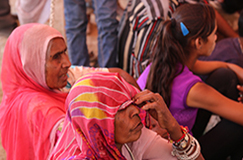
Over 10,000 women got together in a little quiet village called Sukhtawa in Hoshangabad district of Madhya Pradesh last month. These women had gathered from gathered from different regions of the district and state, and were representing various SHGs. The agenda of the event was to discuss the improvement in the conditions of women and their group over the years. As those women stood together, I could see them — even though they came from different villages or SHGs and even spoke the same language but in different dialects — as a joint force, each understanding another’s existence and supporting one another.
I was participating in the event for two reasons. Firstly, to interview some women whose lives had been impacted by digital interventions and, secondly, to witness the meaning and strength of togetherness. As the event started at 11 am, sounds of drums and slogans permeated the quite atmosphere. You could hear them even from a couple of kilometres away. Women sloganeering, dancing, beating the drums and singing through the parade to the designated tented area — that was the celebratory scene in the area. As each woman walked through the tent, one lady at the entrance applied vermilion on her forehead. In fact, the lady had vermilion smudged all over her face because each woman reciprocated the gesture with vermilion.
As the group of women entered the tent, they found their spots and prepared for the day. The infiltrating colours of their traditional attires accompanied the heat, passion and energy that blast through their activities throughout the day. As the temperature rose in the afternoon, women’s energy visibly increased in their speeches, chanting and sloganeering.
The role of men under this tent was restricted. They had a small area designated for them where they sat and listened intently to the flourishing force of women.
Suddenly, the conjoining energy hit a new high when the sound of a howling helicopter began to overshadow the chanting below.
“He is here!” the girl, in the middle of my interview of her, shouts, literally jumping off her seat to get a glimpse of Chief Minister Shivraj Singh Chouhan, putting our discussion on indefinite hold. In the back of her jean pocket, she had a little note, prepared for him.
The event lasted the entire day and even through the night. Everyone had come prepared with some sleeping utilities — bedsheets or dari or newspapers — which they laid on the ground, under the dim green light, and relaxed towards the end of a zealous day.
At 12 am, a group of women began to discuss women’s land ownership right on the stage; at 1 am, a play was performed to show the emerging influence of technology; then a group of trainers from DEF’s CIRC team composed and sang a song about the impact of digital technology.
However, the night did not end at that. Events and discussions continued throughout the night and until dawn. In fact, they had to stay. They were scared that tigers around the vicinity may attack women on their way home (many of the women who had come live in villages with no access to main roads). I left as the temperature began to drop. Some women slept soundly next to other women; for warmth and the notion of togetherness. As speeches and discussion continued and dimming green lingered, some never slept.
About the author: Graphic designer Cathy Pin-Chun Chen is a Taiwanese-Canadian national who interned with Digital Empowerment Foundation a few years ago and then returned to India to work with the organisation. Without knowing their local language, Cathy experiences listening and interacting emphatically in rural and remote parts of India.










